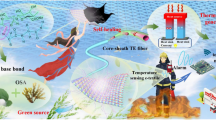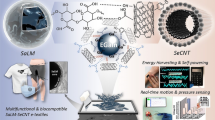Abstract
Graphene has been highlighted in a variety of wearable electronics and smart textiles applications due to its unique properties such as high conductivity, transparency, flexibility and other excellent mechanical performance. Although there have been extensive efforts for graphene based conductive fibers/yarns, there are remaining challenges in terms of the seamless integration between 2D flakes, and reduced charge transport in a lower carrier concentration. Unstable resistance probably arises from the creation of gaps in the conductive parts of the smart textile. Also, regional temperatures can get too high, constituting a fire-safety hazard and endangering the wearer's safety. In this work, the synergistic effect of graphene and flame-retardant materials was investigated, and a conductive fabric was developed which is highly conductive and flame retardancy. Graphene has excellent electrical and thermal conductivity and acts synergistically with traditional flame-retardants on common fabrics. The electrical surface resistivity of hybrid material modified fabrics was as low as 0.54 kΩ/sq, so they could serve as safe and highly conductive conductor in a simple circuit and show excellent wash-ability. The limiting oxygen index of the fabric increased from 19 to 32 after modification in conjunction with the residue at 800 °C increased from 17.9 to 31%, which could be used as safe and highly conductive materials for smart textiles and wearable devices.






Similar content being viewed by others
References
Alimohammadi F, Gashti MP, Mozaffari A (2018) Polyvinylpyrrolidone/carbon nanotube/cotton functional nanocomposite: preparation and characterization of properties. Fiber Polym 19:1940–1947
Atalay O, Atalay A, Gafford J, Walsh C (2018) A Highly sensitive capacitive-based soft pressure sensor based on a conductive fabric and a microporous dielectric layer. Adv Mater Technol 3:1700237–1700244
Cai G, Xu Z, Yang M, Tang B, Wang X (2017) Functionalization of cotton fabrics through thermal reduction of graphene oxide. Appl Surf Sci 393:441–448
Carrillo F, Colom X, Sunol JJ, Saurina J (2004) Structural FTIR analysis and thermal characterisation of lyocell and viscose-type fibres. Eur Polym J 40:2229–2234
Cataldi P, Ceseracciu L, Athanassiou A, Bayer IS (2017) Healable cotton–graphene nanocomposite conductor for wearable electronics. ACS Appl Mater Interfaces 9:13825–13830
Chen T, Hong J, Peng C, Chen G, Yuan C, Xu Y, Dai L (2019) Superhydrophobic and flame-retardant cotton modified with DOPO and fluorine-silicon-containing crosslinked polymer. Carbohydr Polym 208:14–21
Ding X, Lei S, Du C, Xie Z, Li J, Huang X (2019) Small-sized CuS nanoparticles/N, S co-doped rGO composites as the anode materials for high-performance lithium-ion batteries. Adv Mater Interfaces 6:1900038
El-Shafei A, El-Shemy M, Abou-Okeil A (2015) Eco-friendly finishing agent for cotton fabrics to improve flame retardant and antibacterial properties. Carbohydr Polym 118:83–90
Fathy M, Moghny TA, Mousa MA (2019) Fast and fully scalable synthesis of graphene oxide from cellulose by catalytic acid spray method. Arab J Sci Eng 44:305–313
Feng Y, Li X, Zhao X, Ye Y, Zhou X, Liu H, Xie X (2019) Synergetic improvement in thermal conductivity and flame retardancy of epoxy/silver nanowires composites by incorporating “Branch-Like” flame-retardant functionalized graphene. ACS Appl Mater Interfaces 10:21628–21641
Gaan S, Sun G (2007) Effect of phosphorus and nitrogen on flame retardant cellulose: a study of phosphorus compounds. J Anal Appl Pyrolysis 78:371–377
Gashti MP, Almasian A (2013) Citric acid/ZrO2 nanocomposite inducing thermal barrier and self-cleaning properties on protein fibers. Composites B 52:340–349
Gashti MP, Gashti MP (2013) Effect of colloidal dispersion of clay on some properties of wool fiber. J Dispers Sci Technol 34:853–858
Gashti MP, Navid MY, Rahimi MH (2012) Coating of macroemulsion and microemulsion silicones on poly (ethylene terephthalate) fibers: Evaluation of the thermal properties and flammability. J Appl Polym Sci 125:1430–1438
Gashti MP, Navid MY, Rahimi MH (2013a) Effects of coating of nano-and microemulsion silicones on thermal properties and flammability of polyethylene terephthalate textile. Pigm Resin Technol 42:34–44
Gashti MP, Pournaserani A, Ehsani H, Gashti MP (2013b) Surface oxidation of cellulose by ozone-gas in a vacuum cylinder to improve the functionality of fluoromonomer. Vacuum 91:7–13
Gashti MP, Elahi A, Gashti MP (2013c) UV radiation inducing succinic acid/silica–kaolinite network on cellulose fiber to improve the functionality. Composites B 48:158–166
Grancarić AM, Jerković I, Koncar V, Cochrane C, Kelly FM, Soulat D, Legrand X (2018) Conductive polymers for smart textile applications. J Ind Text 48:612–642
Gu JF, Gorgutsa S, Skorobogatiy M (2010) Soft capacitor fibers using conductive polymers for electronic textiles. Smart Mater Struct 19:1–13
Huang G, Gao J, Wang X, Liang H, Ge C (2012) How can graphene reduce the flammability of polymer nanocomposites? Mater Lett 66:187–189
Huang G, Wang S, Song P, Wu C, Chen S, Wang X (2014) Combination effect of carbon nanotubes with graphene on intumescent flame-retardant polypropylene nanocomposites. Composites A 59:18–25
Huang G, Liu L, Wang R, Zhang J, Sun X, Peng H (2016) Smart color-changing textile with high contrast based on a single-sided conductive fabric. J Mater Chem C 4:7589–7594
Liu S, Yan H, Fang Z, Wang H (2014) Effect of graphene nanosheets on morphology, thermal stability and flame retardancy of epoxy resin. Compos Sci Technol 90:40–47
Liu L, Chen Y, Liu H, Rehman HU, Chen C, Kang H, Li H (2019) A graphene oxide and functionalized carbon nanotube based semi-open cellular network for sound absorption. Soft Matter 15:2269–2276
Nooralian Z, Gashti MP, Ebrahimi I (2016) Fabrication of a multifunctional graphene/polyvinylphosphonic acid/cotton nanocomposite via facile spray layer-by-layer assembly. RSC Adv 6:23288–23299
Palaskar S, Kale KH, Nadiger GS, Desai AN (2011) Dielectric barrier discharge plasma induced surface modification of polyester/cotton blended fabrics to impart water repellency using HMDSO. J Appl Polym Sci 122:1092–1100
Pan Y, Liu L, Wang X, Song L, Hu Y (2018) Hypophosphorous acid cross-linked layer-by-layer assembly of green polyelectrolytes on polyester-cotton blend fabrics for durable flame-retardant treatment. Carbohydr Polym 201:1–8
Qing X, Wang Y, Zhang Y, Ding X, Zhong W, Wang D, Lu Z (2019) Wearable fiber-based organic electrochemical transistors as a platform for highly sensitive dopamine monitoring. ACS Appl Mater Interfaces 11:13105–13113
Qu J, He N, Patil SV, Wang Y, Banerjee D, Gao W (2019) Screen printing of graphene oxide patterns onto viscose nonwovens with tunable penetration depth and electrical conductivity. ACS Appl Mater Interfaces 11:14944–14951
Rahimi MH, Parvinzadeh M, Navid MY, Ahmadi S (2011) Thermal characterization and flammability of polyester fiber coated with nonionic and cationic softeners. J Surfactants Deterg 14:595–603
Ren H, Sun J, Wu B, Zhou Q (2007) Synthesis and properties of a phosphorus-containing flame retardant epoxy resin based on bis-phenoxy (3-hydroxy) phenyl phosphine oxide. Polym Degrad Stab 92:956–961
Ren J, Wang C, Zhang X, Carey T, Chen K, Yin Y, Torrisi F (2017) Environmentally-friendly conductive cotton fabric as flexible strain sensor based on hot press reduced graphene oxide. Carbon 111:622–630
Saxena S, Tyson TA, Shukla S, Negusse E, Chen H, Bai J (2011) Investigation of structural and electronic properties of graphene oxide. Appl Phys Lett 99:1838–1845
Shin S, Jang J, Yoon SH, Mochida I (1997) A study on the effect of heat treatment on functional groups of pitch based activated carbon fiber using FTIR. Carbon 35:1739–1743
Simorangkir RB, Yang Y, Esselle KP, Zeb BA (2018) A. Method to realize robust flexible electronically tunable antennas using polymer-embedded conductive fabric. IEEE Trans Antennas Propag 66:50–58
Stankovich S, Dikin DA, Piner RD, Kohlhaas KA, Kleinhammes A, Jia Y, Ruoff RS (2007) Synthesis of graphene-based nanosheets via chemical reduction of exfoliated graphite oxide. Carbon 45:1558–1565
Tian M, Hu X, Qu L, Du M, Zhu S, Sun Y, Han G (2016) Ultraviolet protection cotton fabric achieved via layer-by-layer self-assembly of graphene oxide and chitosan. Appl Surf Sci 377:141–148
Voiry D, Yang J, Kupferberg J, Fullon R, Lee C, Jeong HY, Chhowalla M (2016) High-quality graphene via microwave reduction of solution-exfoliated graphene oxide. Science 353:1413–1416
Wang X, Song L, Yang H, Lu H, Hu Y (2011) Synergistic effect of graphene on antidripping and fire resistance of intumescent flame-retardant poly (butylene succinate) composites. Ind Eng Chem Res 50:5376–5383
Yun Y, Hong W, Kim WJ, Jun Y, Kim BH (2013) A novel method for applying reduced graphene oxide directly to electronic textiles from yarns to fabrics. Adv Mater 25:5701–5705
Zahid M, Papadopoulou EL, Athanassiou A, Bayer IS (2017) Strain-responsive mercerized conductive cotton fabrics based on PEDOT: PSS/graphene. Mater Des 135:213–222
Zhang X, Shi M (2019) Flame retardant vinylon/poly (m-phenylene isophthalamide) blended fibers with synergistic flame retardancy for advanced fireproof textiles. J Hazard Mater 365:9–15
Zhao H, Tian M, Hao Y, Qu L, Zhu S, Chen S (2018) Fast and facile graphene oxide grafting on hydrophobic polyamide fabric via electrophoretic deposition route. J Mater Sci 53:9504–9520
Acknowledgments
The authors would like to acknowledge the financial assistance provided by National Key R&D Program of China (No. 2017YFB0309000) and National Natural Science Foundation of China (No. 51672141).
Author information
Authors and Affiliations
Corresponding author
Ethics declarations
Conflict of interest
The authors declare that they have no conflict of interest.
Additional information
Publisher's Note
Springer Nature remains neutral with regard to jurisdictional claims in published maps and institutional affiliations.
Rights and permissions
About this article
Cite this article
Zhao, Y., Wang, J., Li, Z. et al. Washable, durable and flame retardant conductive textiles based on reduced graphene oxide modification. Cellulose 27, 1763–1771 (2020). https://doi.org/10.1007/s10570-019-02884-1
Received:
Accepted:
Published:
Issue Date:
DOI: https://doi.org/10.1007/s10570-019-02884-1




